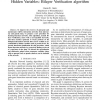Free Online Productivity Tools
i2Speak
i2Symbol
i2OCR
iTex2Img
iWeb2Print
iWeb2Shot
i2Type
iPdf2Split
iPdf2Merge
i2Bopomofo
i2Arabic
i2Style
i2Image
i2PDF
iLatex2Rtf
Sci2ools
BIOCOMP
2006
2006
Learning Genetic and Gene Bayesian Networks with Hidden Variables: Bilayer Verification Algorithm
To improve the recovery of gene-gene and marker-gene (eQTL) interaction networks from microarray and genetic data, we propose a new procedure for learning Bayesian networks. This algorithm, termed Bilayer Verification, starts with a user-specified leaf node, and then searches upstream to locate portions of the biological interaction network that can be verified as unconfounded by hidden variables such as protein levels. We provide theoretical justification for this procedure, which learns Bayesian networks by recursively finding two levels of v-structures in the data. We discuss the specialization and efficiencies gained when exogenous variables (those with no parents) such as genetic markers can be included in the network.
| Added | 30 Oct 2010 |
| Updated | 30 Oct 2010 |
| Type | Conference |
| Year | 2006 |
| Where | BIOCOMP |
| Authors | Jason E. Aten |
Comments (0)

